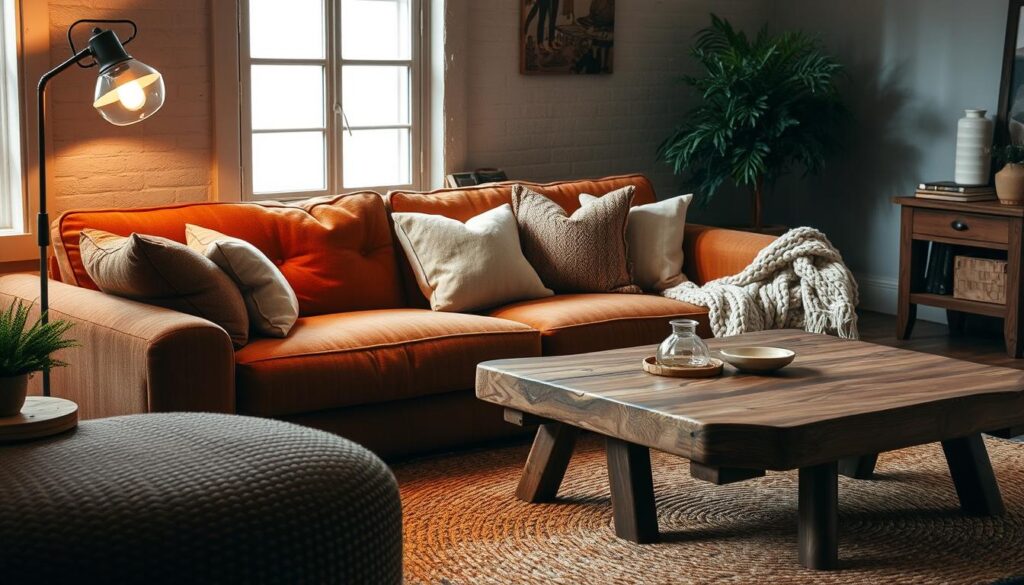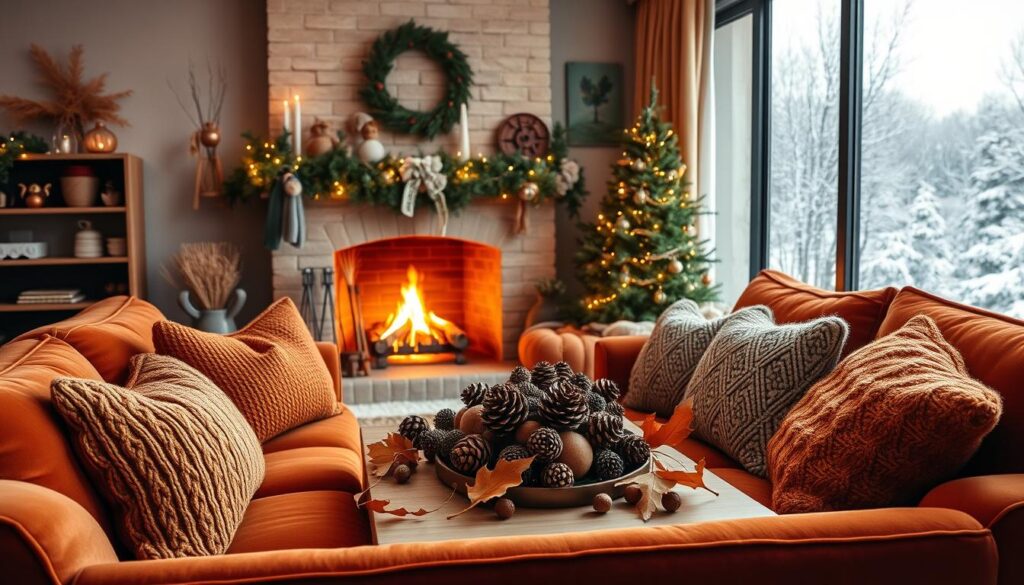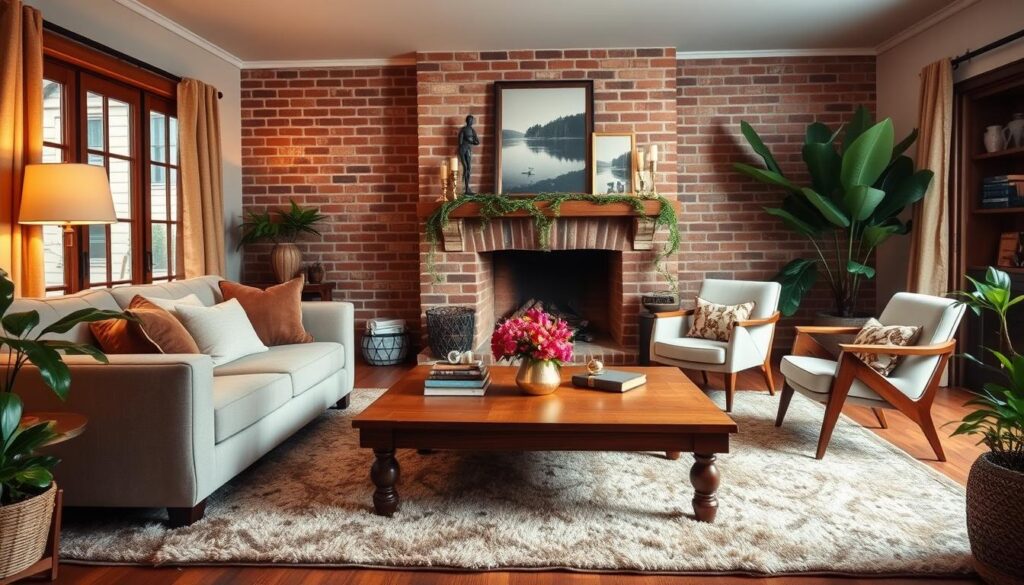Did you know a well-designed living space can make you happier and more productive? Creating a haven that reflects your personality and style is more than just looks. It’s about making a space that improves your well-being.
We believe beautiful spaces show who we are. That’s why we’re excited to share our expert interior decorating ideas. They’ll help you turn your living space into a beautiful and useful haven.
Key Takeaways
- Discover the importance of reflecting your personality in your home decor
- Explore expert tips for elevating your living space
- Learn how to create a functional and beautiful home environment
- Find inspiration for your next home decor project
- Get started on transforming your space with our decorating ideas
Understanding the Basics of Home Interior Design
Turning your home into a cozy retreat starts with understanding interior design basics. To make a space look good and work well, we must focus on several key areas.
Assessing Your Space
First, we need to measure and understand our space. We measure the room, note where doors and windows are, and look at any special features. Getting accurate measurements helps ensure our furniture fits right and the room flows smoothly.
Defining Your Style
Next, we must figure out our personal style. We think about what we like and dislike in our current space and what style we want. Are we into modern simplicity or traditional charm? Looking for inspiration in magazines, online, and social media helps us find our style.
Setting a Budget
Having a clear budget is key to making choices during decorating. We must think about the cost of furniture, decor, and any needed renovations or professional help. By spending wisely, we can meet our design dreams without overspending.
To stretch our budget, we can look for affordable options like updating old furniture, shopping sales, or doing DIY projects. Being smart with our money lets us create a beautiful, functional home without spending too much.
Color Schemes That Transform Rooms
The right color scheme can change a room a lot. It’s key in interior design. Choosing the right colors makes a space look good and feel right.
Colors can change how we feel and how big a room seems. Neutrals are great for a flexible color scheme. They offer a clean look that pairs well with bold colors.
The Power of Neutrals
Beige, cream, and gray are favorites for their calm vibe. They’re also easy to mix with different styles.
“Neutrals are not just boring backgrounds; they are the canvas on which you can create your masterpiece,” says a famous interior designer. Neutrals help create a balanced, welcoming look.
Bold Accent Colors
Bold accent colors bring life and personality to a room. Deep blues, rich greens, and bright yellows make great focal points.
- Use bold accent colors sparingly to avoid overwhelming the space.
- Choose accent colors that complement your neutral base.
- Experiment with different shades to find the perfect balance.
Color Trends to Explore
Keeping up with color trends can spark your design ideas. Earthy tones and soft pastels are in for their cozy feel.
Remember, harmony is key in color schemes. Whether you like neutrals, bold colors, or new trends, the right mix can make your room special.
Understanding color schemes and staying current with interior styling tricks helps you create a home that shows your style and meets your needs.
Furniture Layout Tips for Maximum Impact
The way you arrange your furniture greatly affects your home’s feel and use. A well-thought-out layout boosts your space’s look and makes it more useful.
Creating Flow and Functionality
Planning your space’s flow is key to a harmonious living area. First, think about the room’s main uses. For example, in a living room, arrange furniture to encourage conversation. In small apartments, use apartment decorating hacks like multi-functional furniture.
It’s also important to keep the room open. Don’t overdo it with furniture. This makes the room feel bigger and more useful.
Space-Saving Solutions
In small spaces, finding the right small space decorating solutions is crucial. Use wall-mounted items to clear the floor and make the room seem larger. Choose furniture with legs to make the room feel bigger.
Nesting tables and stackable chairs are great for small spaces. They can be tucked away when not needed. Also, consider furniture that serves more than one purpose, like a storage ottoman.
Focal Points in Design
Creating focal points in a room adds interest and draws the eye. Use furniture to frame a central feature, like a fireplace or artwork. In bedrooms, the bed can be the main attraction.
Bold accent colors or striking lighting can also highlight a focal point. The goal is to balance these elements to avoid overwhelming the room. By arranging furniture thoughtfully and adding focal points, you can make your space both beautiful and practical.
Incorporating Textures for Depth and Interest
Using different textures can make a room come alive. It turns a simple space into a lively, engaging place.
Adding various textures brings depth and interest to a room. They are key in interior design, making a space feel lively and welcoming. Mixing materials thoughtfully creates a rich, layered look that shows off your style.
Choosing Materials: Wood, Metal, and Fabric
There are many materials to choose from for your home decor. Wood, metal, and fabric are three main ones that change a room’s texture.
Wood brings warmth and a natural feel. Different woods, like oak or walnut, add unique textures and colors. For example, a wooden coffee table can make your living room cozy, fitting with cozy home decor ideas.
Metal adds a sleek, modern touch. It could be a metallic accent wall or metal-framed furniture. This material brings a sophisticated feel, offering interior design inspiration.
Fabric is also very versatile. It can change a room’s texture a lot. From plush carpets to velvet sofas, fabric adds a touchable feel. Mixing fabrics, like linen and cotton, creates a visually interesting look.
| Material | Texture | Example Use |
|---|---|---|
| Wood | Warm, natural | Wooden coffee table |
| Metal | Sleek, modern | Metallic accent wall |
| Fabric | Tactile, varied | Velvet sofa |
Layering Textures Effectively
To make a space look good, layer different textures. Start with a main texture, like a plush area rug. Then add secondary textures, like a wooden side table or a metal vase.
Tips for Layering Textures:
- Mix materials, like wood and metal, for contrast.
- Add fabric, like throw blankets and pillows, for depth.
- Balance smooth textures, like metal, with rough ones, like wood.

By mixing and layering textures, you can make your home cozy and inviting. It shows off your style. The secret is to find balance and harmony.
Lighting Strategies to Enhance Ambiance
Good lighting can change a room’s feel, making it key in home design. It lights up spaces and sets the mood. It also makes a room more functional.
Natural vs. Artificial Lighting
Natural and artificial lighting work together for a balanced look. Natural light is energy-saving and lifts our mood. But, it’s not always enough, like at night or in small rooms.
Artificial lighting gives us control over the room’s feel. We suggest using natural light during the day with sheer curtains. Then, switch to artificial light as needed. For more tips, check out Artika’s lighting blog.
Layered Lighting Techniques
Layered lighting uses different lights for a welcoming feel. It includes:
- Ambient lighting: Lights up the whole room.
- Task lighting: Focuses on areas for activities.
- Accent lighting: Shows off special features or decor.
This method creates a lighting plan that works for all times and moods.
Choosing the Right Fixtures
Picking the right lights is key to matching your design. Think about the style, size, and use of the lights. They should fit the room’s look and purpose.
For example, modern spaces look good with simple lights. But, ornate lights are better for traditional or vintage rooms.
| Room Type | Recommended Lighting Type | Fixture Suggestions |
|---|---|---|
| Living Room | Layered Lighting | Table lamps, Floor lamps, Ceiling fixtures |
| Kitchen | Task Lighting | Under-cabinet lighting, Pendant lights |
| Bedroom | Ambient & Accent Lighting | Bedside lamps, String lights |
Personalizing Your Space with Decor
To turn your house into a home, add personal touches through decor. Personalizing your space is like telling a story through your decor choices. It should reflect who you are.
Adding personality to your home starts with artwork. You can choose from paintings, prints, sculptures, or photographs. Pick pieces that speak to you personally.
The Importance of Artwork
Artwork can change a room’s feel, adding color and character. Think about the style and era you like. For example, modern art can make a bold statement in a simple room.
When displaying artwork, consider size and scale. A big piece can stand out in a large room. Smaller pieces can create a gallery wall in a hallway or above a sofa.
Accessories That Reflect You
Accessories are key in making your space personal. This includes decorative objects, rugs, throw pillows, and more. They add color and texture to your rooms.
Choose accessories that show your personality or interests. For instance, travel souvenirs or maps can add a personal touch.
| Accessory Type | Ideas | Tips |
|---|---|---|
| Decorative Objects | Vases, sculptures, figurines | Choose objects that resonate with your personal style or interests. |
| Rugs | Area rugs, runners | Select rugs that complement your furniture and add warmth underfoot. |
| Throw Pillows | Varied patterns, textures, and sizes | Use throw pillows to add pops of color and texture to your furniture. |
Plants and Greenery
Plants and greenery are great for personalizing your space. They purify the air, improve ambiance, and add a natural touch. This can make your space feel more soothing.
Choose plants that fit your lifestyle and home conditions. Succulents and snake plants are easy to care for. Ferns and peace lilies can add elegance.
By adding artwork, accessories, and plants, you can make your home truly yours. It becomes a warm and welcoming space for everyone.
Utilizing Space Wisely: Small Apartments to Large Homes
Maximizing space in our homes is a big challenge. It doesn’t matter if we have a small apartment or a big house. The secret to a cozy and useful living space is using our space well.
Multi-Functional Furniture
One great small space decorating solution is using furniture that does more than one thing. For example, a storage ottoman or a sofa bed can save space and keep things tidy.
A coffee table with storage can help keep your living area clean. It’s a place for books, magazines, and remotes. A desk with shelves can also keep your workspace organized.
Creative Storage Solutions
Creative storage is key for apartment decorating hacks. Using wall-mounted shelves or storage can make rooms feel bigger.
Under-bed storage boxes and closet organizers are smart ways to save space. They help keep things organized and out of the way, making rooms feel larger.
Visual Tricks for Small Spaces
There are also visual tricks to make small spaces look bigger. Using light colors on walls and floors can make a room feel more open and bright.
Mirrors are great too. A big mirror opposite a window can reflect light and make a room seem larger. Also, keeping things simple and clutter-free can make a space feel more open.
By using these ideas, we can make our living spaces cozy, useful, and beautiful, no matter their size.
Seasonal Decorating Ideas to Refresh Your Home
Every season brings a chance to make your home look new again. Seasonal decorating isn’t just for holidays. It’s a way to keep your home feeling lively and updated all year.
Embracing Seasonal Colors
Changing your colors is a simple way to refresh your home. Spring is perfect for soft pastels and fresh greens. Summer is for bright colors and bold looks.
Autumn brings warm tones like orange, red, and yellow for a cozy feel. Winter is the time for icy blues and silvers.

Utilizing Holiday Decor
Holidays are a great time to decorate and add seasonal flair. For Christmas, use red and green. Halloween calls for orange and black.
It’s smart to store your holiday decor in labeled boxes. This makes it easy to find them next year.
Rotating Your Decor
Changing your decor with the seasons doesn’t have to be hard. Start with small changes like throw pillows or blankets. Adding a seasonal centerpiece is also a good idea.
Updating your wall art can also reflect the season. This way, your home stays fresh without needing a big change.
| Season | Color Palette | Decor Ideas |
|---|---|---|
| Spring | Soft pastels, fresh greens | Floral arrangements, greenery |
| Summer | Vibrant hues, bold colors | Beach-themed decor, bright textiles |
| Autumn | Warm tones (orange, red, yellow) | Pumpkins, fall leaves, warm lighting |
| Winter | Icy blues, silvers | Winter wonderland scenes, frosted glass |
By using these seasonal decorating ideas, your home will always look its best. Whether you make small changes or big ones, the most important thing is to have fun and be creative.
Sustainable Decorating Practices
As we become more aware of our environmental impact, we’re turning to sustainable decorating. This change aims to make our homes beautiful and good for the planet.
Using eco-friendly materials is a big part of sustainable decorating. These materials are made and sourced in ways that are kind to the environment. For example, reclaimed wood, bamboo, and paints with low VOCs are great choices. You can learn more about sustainable home decor at The Spruce.
Eco-Friendly Materials
When picking materials for your home, think about the environmental cost. Sustainable materials are good for the planet and can add beauty to your decor.
| Material | Eco-Friendly Aspect | Decorative Use |
|---|---|---|
| Reclaimed Wood | Reduces waste and preserves history | Flooring, furniture, wall decor |
| Bamboo | Fast-growing, renewable resource | Furniture, flooring, blinds |
| Low-VOC Paints | Reduces indoor air pollution | Walls, ceilings, trim |
Upcycling Ideas
Upcycling is a creative way to breathe new life into old items. It’s a fun and rewarding process that can lead to unique decor. For example, you can turn old pallets into coffee tables or use vintage jars as vases. For more ideas, check out the latest trends at Ouma Atelier.
Supporting Local Artisans
Supporting local artisans is also key to sustainable decorating. Choosing handmade, local items reduces transportation carbon and supports the local economy. Local artisans add unique perspectives and craftsmanship to your home.
In conclusion, embracing sustainable decorating is a step towards a greener home. By picking eco-friendly materials, upcycling, and supporting local artisans, we can positively impact the planet and beautify our homes.
Staying Updated with Interior Design Trends
To keep your home looking its best, it’s key to stay in the loop with the latest trends. We get inspiration from many places, like design blogs and social media. This helps keep our spaces modern and chic.
Resources for Inspiration
Websites like Houzz and Pinterest are full of design ideas. They show off the work of designers and homeowners. We can look through photos, save our favorites, and make boards to plan our designs.
Following Influential Designers
Designers like Kelly Wearstler and Jonathan Adler share their knowledge through books and social media. By following them, we get the latest trends and tips for our homes.
The Impact of Social Media on Design
Instagram has changed how we find and share design trends. We can follow our favorite designers and brands. This way, we always have the latest styles and ideas to update our homes.


